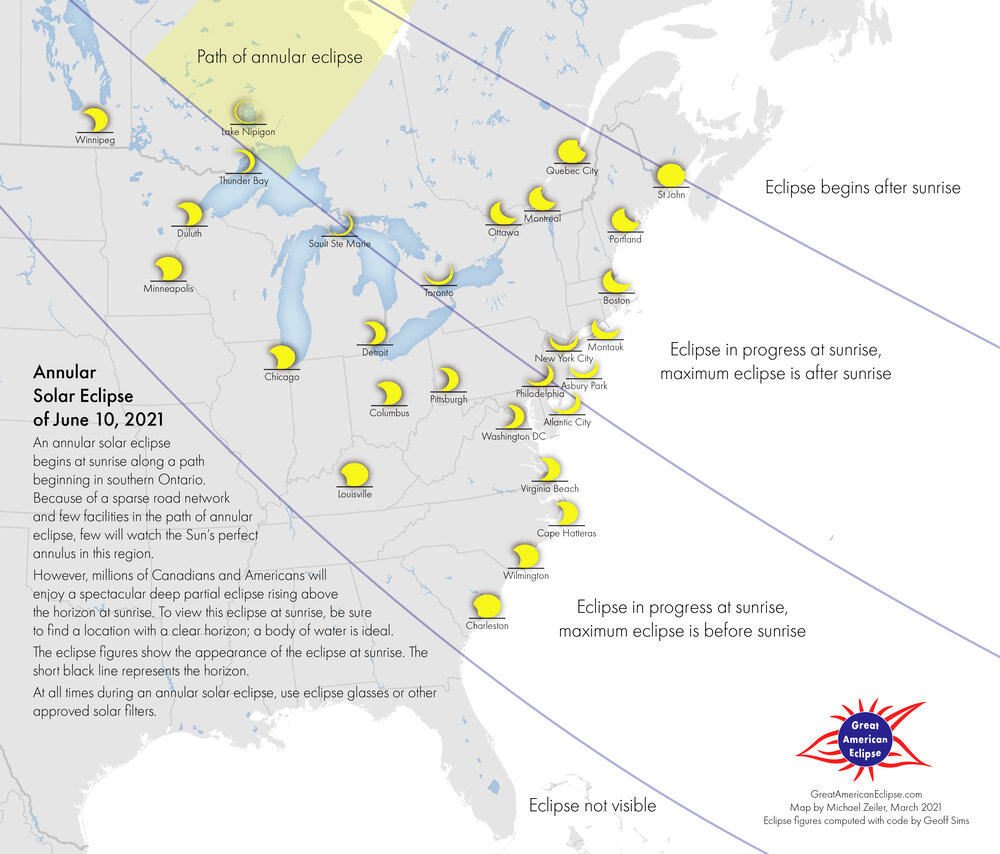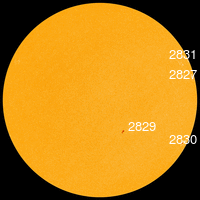Juno Spacecraft Makes Historic Close Flyby of Ganymede!
And here’s the first image so far – beautiful!


Jupiter and Saturn appear low in the southeastern sky around 2:00 AM, and high in the southern sky before dawn; Jupiter has moved away from Saturn quite a bit from their close conjunction last December. Compare this image with the position of Jupiter and Saturn in the Middle Solar System image.

A very thin waning Crescent Moon appears in the eastern predawn sky on June 8th.

Mars and Venus appear above the western horizon after sunset, The Moon appears in conjunction with Venus on June 11th, and Mars on June 13th.
-

A very VERY thin waxing Crescent Moon appears in conjunction with Venus in the northwestern sky at dusk on June 11th; Mars appears higher above the horizon and a bit south of Venus. Credit: Bob Trembley / Stellarium. -

A very thin waxing Crescent Moon appears in conjunction with the star Pollux in the northwestern sky at dusk on June 12th; Venus appears above the horizon and a bit north of Mars. Credit: Bob Trembley / Stellarium. -

A thin waxing Crescent Moon appears in conjunction with Mars in the northwestern sky at dusk on June 13th; Venus appears above the horizon and a bit north of Mars. Credit: Bob Trembley / Stellarium.
The constellation Scorpius appears in the south-southeastern sky after sunset – the very bright red giant star Antares makes finding this constellation fairly easy.


The Moon is a Waning Crescent – visible low to the east before sunrise.
The New Moon occurs on June 10th.
After June 10th, the Moon will be a Waxing Crescent – visible to the southwest in the early evening.

If you click on the Moon image above, or click this link, you will go to NASA’s Moon Phase and Libration, 2021 page – it will show you what the Moon looks like right now. If you click the image on that page, you will download a high-rez TIFF image annotated with the names of prominent features – helpful for logging your lunar observations!
Moon News:


The Sun has numerous spots – none pose a threat for strong solar flares.

Several regions of coronal loop activity – a couple of them rotating out of view. The northern coronal hole remains open and large, and the southern hole remains small; there are couple coronal holes on the Sun’s face – one large one in the southern hemisphere, about to rotate out of view.
Lots of small prominences on the Sun’s limb; all the sunspot locations appear as bright orange in the video below:
You can view the Sun in near real-time, in multiple frequencies here: SDO-The Sun Now.
You can create your own time-lapse movies of the Sun here: AIA/HMI Browse Data.
You can browse all the SDO images of the Sun from 2010 to the present here: Browse SDO archive.
Solar Activity on Facebook – Run by Volunteer NASA/JPL Solar System Ambassador Pamela Shivak

Solar Corona
Solar wind speed is 479.0 km/sec ▲▲, with a density of 4.2 protons/cm3 ▼ at 1141 UT.
Click here to see a near real-time animation of the corona and solar wind from the Solar & Heliospheric Observatory (SOHO).
Sun News:

- Near-Earth Objects (NEOs) discovered this month: 35, this year: 1161 (+61), all time: 25,995 (+107)
- Potentially hazardous asteroids: 2182 (+1) (updated 2021-06-08)
- Total Minor Planets discovered (NASA): 1,091,831 (+8372)
- Total Minor Planets discovered (MPC): 1,069,906 (-1) (updated 2021-06-08)
Upcoming Earth-asteroid encounters:
| Asteroid | Date(UT) | Miss Distance | Velocity (km/s) | Diameter (m) |
| 2021 KZ2 | 2021-Jun-11 | 12.2 LD | 6.7 | 31 |
| 2021 JM6 | 2021-Jun-12 | 11 LD | 8.3 | 38 |
| 441987 | 2021-Jun-25 | 15.6 LD | 13.4 | 187 |
| 2021 JT8 | 2021-Jun-25 | 20.1 LD | 7.5 | 69 |
| 2021 GM4 | 2021-Jul-01 | 12.1 LD | 6.3 | 150 |
| 2020 AD1 | 2021-Jul-04 | 2.8 LD | 4.9 | 20 |
| 2019 AT6 | 2021-Jul-13 | 4.2 LD | 5.1 | 11 |
| 2019 NB7 | 2021-Jul-17 | 15.2 LD | 13.8 | 12 |
| 2014 BP43 | 2021-Jul-21 | 17 LD | 8.5 | 18 |
| 2008 GO20 | 2021-Jul-26 | 10.9 LD | 8.3 | 123 |
| 2020 BW12 | 2021-Jul-27 | 16.7 LD | 9.8 | 21 |
| 2019 YM6 | 2021-Jul-31 | 17.9 LD | 13.5 | 135 |
| 2020 PN1 | 2021-Aug-03 | 9.6 LD | 4.6 | 30 |
| 2020 PP1 | 2021-Aug-03 | 13 LD | 3.6 | 16 |
Asteroid News:

On June 8, 2021, the NASA All Sky Fireball Network reported 10 fireballs!
(6 sporadics, 1 Arietid)

Fireball News:
If you see a bright meteor or a fireball, please REPORT IT to the American Meteor Society and the International Meteor Organization!

Position of the planets & several spacecraft in the inner solar system on June 8th – The Parker Solar Probe has crossed the orbit of Venus. OSIRIS-REx has moved away from asteroid Bennu enough so that the labels are not on top of each other.

Position of the planets in the middle solar system:

Position of the planets, and a several spacecraft in the outer solar system:

Solar System News:

See a list of current NASA missions here: https://www.jpl.nasa.gov/missions/?type=current

ex·o·plan·et /ˈeksōˌplanət/, noun: a planet orbiting a star other than the Sun.
Data from the NASA Exoplanet Archive
* Confirmed Planets Discovered by TESS refers to the number planets that have been published in the refereed astronomical literature.
* TESS Project Candidates refers to the total number of transit-like events that appear to be astrophysical in origin, including false positives as identified by the TESS Project.
* TESS Project Candidates Yet To Be Confirmed refers to the number of TESS Project Candidates that have not yet been dispositioned as a Confirmed Planet or False Positive.
Exoplanet News:

SpaceWeather.com Realtime Aurora Gallery: https://spaceweathergallery.com/aurora_gallery.html

Zion National Park has been certified as an International Dark Sky Park
Zion National Park on Facebook is holding a dark sky photo contest – here are a couple entries:


Visit an International Dark Sky Park: https://www.darksky.org/our-work/conservation/idsp/parks/
If you live in Michigan, visit the Michigan Dark Skies site: https://sites.lsa.umich.edu/darkskies/

For Teachers:
Size and Distance – always an important topic in astronomy to discuss!
Beautiful Universe: M104 – The Sombrero Galaxy

NASA’s Hubble Space Telescope has trained its razor-sharp eye on one of the universe’s most stately and photogenic galaxies, the Sombrero galaxy, Messier 104 (M104).
“The galaxy’s hallmark is a brilliant white, bulbous core encircled by the thick dust lanes comprising the spiral structure of the galaxy. As seen from Earth, the galaxy is tilted nearly edge-on. We view it from just six degrees north of its equatorial plane. This brilliant galaxy was named the Sombrero because of its resemblance to the broad rim and high-topped Mexican hat.
At a relatively bright magnitude of +8, M104 is just beyond the limit of naked-eye visibility and is easily seen through small telescopes. The Sombrero lies at the southern edge of the rich Virgo cluster of galaxies and is one of the most massive objects in that group, equivalent to 800 billion suns. The galaxy is 50,000 light-years across and is located 28 million light-years from Earth.
Hubble easily resolves M104’s rich system of globular clusters, estimated to be nearly 2,000 in number – 10 times as many as orbit our Milky Way galaxy. The ages of the clusters are similar to the clusters in the Milky Way, ranging from 10-13 billion years old. Embedded in the bright core of M104 is a smaller disk, which is tilted relative to the large disk. X-ray emission suggests that there is material falling into the compact core, where a 1-billion-solar-mass black hole resides.”
In the 19th century, some astronomers speculated that M104 was simply an edge-on disk of luminous gas surrounding a young star, which is prototypical of the genesis of our solar system.
“But in 1912, astronomer V. M. Slipher discovered that the hat-like object appeared to be rushing away from us at 700 miles per second. This enormous velocity offered some of the earliest clues that the Sombrero was really another galaxy, and that the universe was expanding in all directions.
The Hubble Heritage Team took these observations in May-June 2003 with the space telescope’s Advanced Camera for Surveys. Images were taken in three filters (red, green, and blue) to yield a natural-color image. The team took six pictures of the galaxy and then stitched them together to create the final composite image. One of the largest Hubble mosaics ever assembled, this magnificent galaxy has an apparent diameter that is nearly one-fifth the diameter of the full moon.” – Hubblesite
Here is a zoomable image of the Sombrero Galaxy: [Link]
What I was listening to while I was writing this:
Stay safe, be well, and look up!
Software Apps used for this post:
NASA Eyes on the Solar System: an immersive 3D solar system and space mission simulator – free for the PC /MAC. I maintain the unofficial NASA Eyes Facebook page.
SpaceEngine: a free 3D Universe Simulator for Windows. Steam version with VR support available.
Stellarium: a free open source planetarium app for PC/MAC/Linux. It’s a great tool for planning observing sessions. A web-based version of Stellarium is also available.


